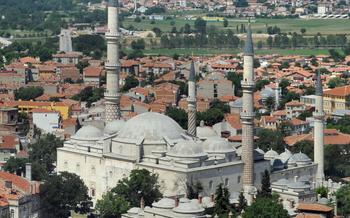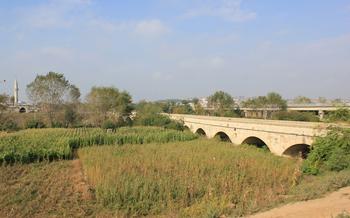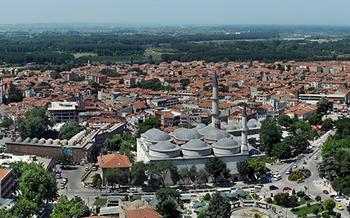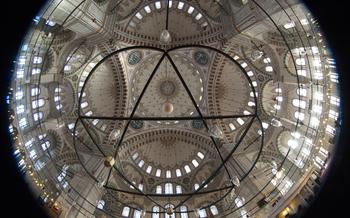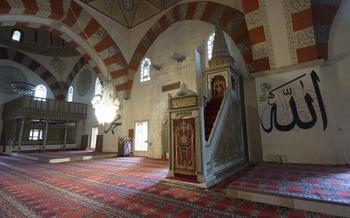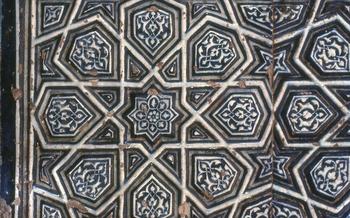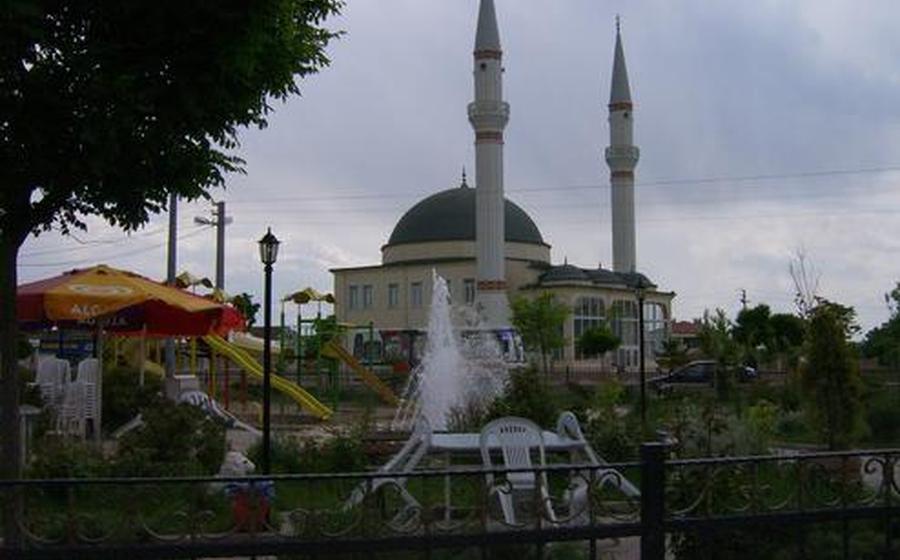
Lalapaşa Mosque
- Historical Significance
- Unique Features
- Interior Beauty
- Surrounding Area
- Visiting Information
- Prayer Services
- Historical Context
- Restoration and Preservation
- Cultural Significance
- Local Customs and Etiquette
- Photography and Videography
- Accessibility
- Local Festivals and Events
- Educational Programs
Historical Significance
The Lalapaşa Mosque stands as a testament to the rich history and cultural heritage of Edirne and the Ottoman Empire. Built in the 15th century during the reign of Sultan Murad II, the mosque played a pivotal role in the city's development as a center of Islamic scholarship and spirituality. Its construction was overseen by Lala Şahin Pasha, a prominent Ottoman statesman and military commander, who commissioned the mosque as a symbol of the empire's power and devotion. The mosque's architectural style reflects the transition from the classical Ottoman style to the more ornate and elaborate style that would come to define the later periods of the empire. As one of Edirne's most prominent landmarks, the Lalapaşa Mosque embodies the city's historical significance and continues to be a source of pride and reverence for the local community.
Unique Features
The Lalapaşa Mosque stands out with its distinctive architectural elements, which showcase the blending of Islamic and Byzantine influences. Its most striking feature is its octagonal dome, a unique design element in Turkish mosque architecture. The dome is supported by eight massive pillars and features intricate geometric patterns and calligraphy, creating a visually captivating ceiling. The mosque also boasts two elegant minarets, which rise high above the surrounding cityscape and offer panoramic views of Edirne.
Another notable feature of the Lalapaşa Mosque is its intricate tilework, which adorns the interior and exterior walls. The tiles feature a variety of vibrant colors and intricate patterns, creating a mesmerizing visual display. The tiles depict various Islamic motifs, including floral patterns, geometric designs, and verses from the Quran, showcasing the artistry and craftsmanship of the Ottoman period. The unique blend of architectural elements and intricate decorations makes the Lalapaşa Mosque a true masterpiece of Islamic architecture.
Interior Beauty
The interior of the Lalapaşa Mosque is a testament to the exquisite craftsmanship and artistry of the Ottoman Empire. The spacious prayer hall, adorned with elegant chandeliers and intricate tilework, creates a breathtaking atmosphere of devotion and tranquility. The mihrab, the niche indicating the direction of Mecca, is a masterpiece of Islamic art, featuring intricate carvings and colorful mosaics that symbolize the sacredness of the space.
The mosque's interior decorations are not merely aesthetic embellishments; they hold deep symbolic meanings and reflect the rich cultural heritage of the region. The calligraphy adorning the walls and arches features verses from the Quran, reminding worshippers of the divine presence that permeates the mosque. The stained glass windows, with their vibrant hues and intricate patterns, cast a soft, ethereal light that enhances the spiritual ambiance.
The acoustics of the Lalapaşa Mosque are another remarkable feature that contributes to its spiritual atmosphere. The carefully designed dome and arches create a natural reverberation that amplifies the sound of prayers and recitations, creating a sense of unity and devotion among the worshippers. The harmonious blending of architectural elements and acoustics transforms the mosque into a sacred space that fosters a deep connection with the divine.
Surrounding Area
The Lalapaşa Mosque is nestled in the heart of Edirne, a city steeped in history and cultural heritage. The mosque's strategic location makes it a central landmark, surrounded by an array of attractions that invite exploration.
In the immediate vicinity, visitors can discover the charming Edirne Bazaar, a bustling marketplace where vendors display an array of local handicrafts, souvenirs, and traditional Turkish delights. The bazaar offers a glimpse into the city's vibrant commercial past and provides an opportunity to interact with friendly locals.
A short walk from the mosque leads to the historic Edirne Castle, an impressive fortress that once served as the administrative center of the Ottoman Empire. The castle's imposing walls, towers, and gates stand as a testament to the city's rich military heritage. Visitors can explore the castle's grounds, marvel at its architectural details, and soak in the panoramic views of Edirne from its ramparts.
For those seeking spiritual enlightenment, the Selimiye Mosque, a masterpiece of Ottoman architecture, is a must-visit. Located just a few kilometers from the Lalapaşa Mosque, the Selimiye Mosque boasts intricate tilework, soaring domes, and a graceful minaret that dominates the city's skyline. Its interior is adorned with exquisite calligraphy, stained glass windows, and intricate carvings, creating an atmosphere of awe and serenity.
Edirne is also renowned for its culinary delights, and visitors can savor the city's signature dishes at nearby restaurants. From traditional Turkish kebabs to mouthwatering desserts, the local cuisine offers a delectable journey for food enthusiasts.
Visiting Information
Visiting the Lalapaşa Mosque is a unique and rewarding experience for travelers and pilgrims alike. To ensure a smooth and respectful visit, here are some essential details to keep in mind:
Visiting Hours: The mosque is generally open to visitors daily, but it is advisable to check with local authorities or the mosque's administration for specific opening hours.
Dress Code: As a place of worship, the mosque requires visitors to dress modestly and respectfully. This means covering shoulders and knees for both men and women. Visitors may be provided with appropriate coverings if needed.
Admission Fees: Entry to the mosque is free of charge, allowing everyone to experience its beauty and tranquility without financial barriers.
Reaching the Mosque: The Lalapaşa Mosque is conveniently located in the heart of Edirne, making it easily accessible by foot, public transportation, or taxi. Several bus routes stop nearby, and there are designated parking areas for those arriving by car.
Best Time to Visit: To avoid crowds and enjoy a more serene experience, it is recommended to visit the mosque during the early morning or late afternoon hours. This will allow you to fully appreciate the mosque's architecture, intricate details, and peaceful atmosphere.
Prayer Services
The Lalapaşa Mosque stands as a pivotal hub for spiritual fulfillment, welcoming Muslim worshippers from all walks of life to partake in the sacred act of prayer. Adhering to the tenets of Islam, the mosque observes a rigorous daily prayer schedule, commencing with the pre-dawn Fajr prayer and culminating in the nightfall Isha prayer. Each prayer is heralded by the melodious call to prayer, known as the azan, reverberating through the city, inviting the faithful to congregate within the mosque's hallowed walls.
Visitors are cordially invited to participate in or observe these prayers, immersing themselves in the mosque's spiritual ambiance. The mosque's spacious prayer hall, adorned with intricate designs and elegant chandeliers, provides a serene and uplifting environment for worshippers to connect with the divine. The mosque's acoustics, meticulously engineered to enhance the recitation of prayers, create a harmonious and immersive soundscape that further elevates the spiritual experience.
Throughout the year, the mosque also hosts special prayer services and religious events that attract devotees from near and far. These events, steeped in tradition and devotion, offer a unique opportunity for visitors to witness the depth and fervor of Islamic faith. Whether it's the solemn observance of Ramadan or the joyous celebration of Eid, these events provide a glimpse into the rich tapestry of Islamic culture and customs.
Historical Context
Edirne, once the second capital of the Ottoman Empire, is a city steeped in history and cultural significance. The Lalapaşa Mosque stands as a testament to the city's rich past and its enduring legacy as a center of Islamic learning and spirituality. Built in the 15th century during the reign of Sultan Murad II, the mosque played a pivotal role in the city's development and served as a symbol of the empire's power and influence.
The mosque's construction was commissioned by Lala Şahin Paşa, a prominent Ottoman grand vizier and military commander. Lala Şahin Paşa was a close advisor to Sultan Murad II and held a high position in the Ottoman court. His patronage of the mosque reflects his devotion to Islam and his desire to leave a lasting legacy in the city he governed.
The Lalapaşa Mosque stands as a testament to the architectural prowess of the Ottoman Empire. Its construction showcases the empire's mastery of Islamic architecture, blending traditional elements with innovative design features. The mosque's grandeur and elegance are a reflection of the Ottoman Empire's wealth and power during its golden age.
Restoration and Preservation
The Lalapaşa Mosque has undergone several restoration and conservation efforts throughout its history to preserve its architectural integrity and historical significance. The first major restoration took place in the 16th century during the reign of Sultan Süleyman the Magnificent. During this renovation, the mosque's exterior was repaired, and its interior was adorned with new tilework and calligraphy. Subsequent restoration projects were carried out in the 18th and 19th centuries, focusing on maintaining the mosque's structure and decorative elements.
In the 20th century, the Lalapaşa Mosque underwent a comprehensive restoration project led by the Turkish Ministry of Culture and Tourism. This project involved repairing the mosque's foundation, reinforcing its walls, and restoring its domes and minarets. The mosque's interior was also meticulously restored, with the restoration of the mihrab, minbar, and chandeliers. The project aimed to preserve the mosque's original architectural features while ensuring its structural stability and safety for visitors.
Preserving a significant landmark like the Lalapaşa Mosque presents several challenges. One challenge lies in balancing the need for restoration with maintaining the mosque's historical authenticity. Restorers must carefully assess which elements require repair or replacement while preserving the original character of the mosque. Additionally, finding skilled artisans and craftsmen who specialize in traditional Islamic architecture is crucial to ensure the restoration work is executed with precision and respect for the mosque's heritage.
Despite these challenges, the restoration efforts have successfully preserved the Lalapaşa Mosque as a testament to Ottoman architecture and Islamic art. The mosque continues to stand as a symbol of Edirne's rich cultural and religious heritage, welcoming visitors from around the world to admire its architectural beauty and spiritual significance.
Cultural Significance
The Lalapaşa Mosque stands as a testament to the rich cultural heritage of Turkey and the Islamic world. Its architectural grandeur, intricate decorations, and spiritual atmosphere reflect the values, traditions, and beliefs of the local community. The mosque serves as a place of gathering, prayer, and reflection, fostering a sense of unity and belonging among its worshippers. It is a symbol of the city's diverse cultural tapestry, where Islamic architecture harmoniously blends with Turkish traditions and influences.
The mosque's cultural significance extends beyond its religious function. It is a popular tourist destination, attracting visitors from around the world who come to admire its beauty and learn about its history. The mosque's unique architectural style, with its blend of Ottoman and Byzantine influences, has earned it recognition as a UNESCO World Heritage Site. It is also a popular venue for cultural events, exhibitions, and educational programs, promoting interfaith dialogue and understanding among people of different backgrounds.
The Lalapaşa Mosque is deeply embedded in the cultural fabric of Edirne and Turkey, representing the enduring legacy of the Ottoman Empire and the vibrant Islamic traditions that continue to shape the region's identity. It is a symbol of unity, cultural exchange, and the enduring power of faith.
Local Customs and Etiquette
When visiting the Lalapaşa Mosque, it is essential to be mindful of local customs and etiquette to show respect for the mosque's sacredness and the Muslim community. Upon entering the mosque, visitors should remove their shoes and place them on the designated shelves or racks. Modest attire is expected, with shoulders and knees covered. Visitors should avoid wearing shorts, tank tops, or revealing clothing.
Maintaining a respectful demeanor is crucial. Avoid loud conversations, laughter, or any actions that may disrupt the tranquility of the mosque. It is considered disrespectful to point your feet or shoes towards the qibla, the direction of prayer towards Mecca. When taking photos, avoid using flash or disturbing worshippers. Always ask for permission before photographing people, especially women.
By following these simple guidelines, visitors can demonstrate their respect for the mosque's religious significance and contribute to preserving its peaceful atmosphere.
Photography and Videography
Photography and videography are generally permitted inside the Lalapaşa Mosque, allowing visitors to capture the mosque's beauty and grandeur. However, it is crucial to be respectful and mindful of the sacredness of the space. Using flash photography is discouraged, as it can be disruptive to worshippers and damage the delicate interior decorations. Visitors should also avoid disturbing worshippers or taking photos of people without their consent. Instead, focus on capturing the mosque's architectural details, intricate tilework, and overall atmosphere. Alternatively, consider sketching or painting the mosque as a way to preserve your memories.
Accessibility
The Lalapaşa Mosque is committed to providing an inclusive and welcoming environment for all visitors. It features accessible features to accommodate individuals with disabilities. Wheelchair ramps and elevators are available to ensure easy access to the mosque's prayer hall and other areas. Additionally, designated areas and restrooms are designed to cater to the needs of visitors with special requirements. The mosque's staff is trained to assist and provide support to ensure a comfortable and fulfilling experience for all.
Local Festivals and Events
The Lalapaşa Mosque is not only a place of worship but also a venue for various local festivals and events that showcase the city's rich cultural heritage. One of the most notable events is the annual Lalapaşa Mosque Festival, held during the summer months. This vibrant festival draws visitors from near and far to celebrate the mosque's history and significance. During the festival, the mosque's courtyard transforms into a lively hub of activity, with traditional music performances, folkloric dances, art exhibitions, and food stalls offering local delicacies. Locals and tourists alike come together to experience the city's vibrant culture and celebrate the mosque's enduring legacy.
Educational Programs
The Lalapaşa Mosque is not just a place of worship but also a center for learning and cultural exchange. The mosque collaborates with local organizations to offer educational programs that promote religious understanding, interfaith dialogue, and cultural exchange. These programs aim to foster mutual respect and understanding among people of different faiths and backgrounds.
Visitors to the mosque can participate in guided tours that provide insights into Islamic architecture, history, and culture. These tours are led by knowledgeable guides who share their expertise and answer questions from visitors. Additionally, the mosque hosts workshops, seminars, and lectures on various topics related to Islam, Turkish culture, and interfaith dialogue.
By participating in these educational programs, visitors can gain a deeper understanding of the mosque's significance and its role in promoting cultural harmony. These programs provide a unique opportunity for visitors to engage with the local community, learn about different perspectives, and contribute to building bridges between cultures.

